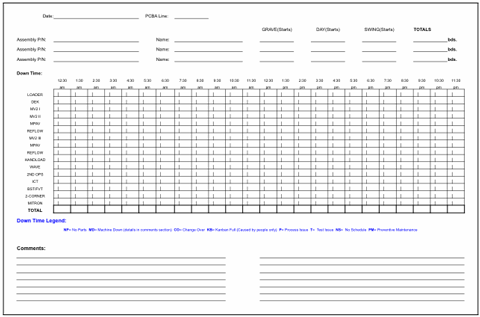CONTACT US

Tel: 0084 334106955
China Tel Phone:0086.183.1941.4171
VN Moible Phone: 0084 0334106955
Email:Longsonghongkong@gmail.com
В Original Equipment Manufacturers (OEM)В and electronics manufacturing services (EMS) providers are not immune to the pressures of the current economic downturn. All manufacturers are investigating methods to reduce overhead costs. It is not just a matter of sound business practices вҖ“ it is a matter of survival.
And with all cost-cutting ventures, one might consider reducing or eliminating preventative maintenance practices on equipment. Preventative maintenance is an overhead function. Reduce it and one can reduce the cost of ownership. Funds used on preventative maintenance can be applied elsewhere within your business.
Figure 1 depicts the process flow of a typical surface mount technology (SMT) manufacturing production line. If fully automated, as in a high volume environment manufacturing commercial hardware, there are no manual operations.
Even if specific processes can be performed manually, such as screen printing, component placement, and the inspection operations, such manual performances will be less efficient and slower than their automated counterparts. Product quality would be compromised and chances of hitting yourВ printed circuit board six sigmaobjectives can be thrown out the window.Therefore, if any of the eight processes illustrated are down for an extended period due to equipment being down, the entire line is unavailable for production.
В
В
В
В
В
В
Downtime due to a manufacturing process will lead to expensive disruptions in production. Downtime is defined as the period of time when production equipment is not operating due to a series of malfunctions.
When production hardware is down due to improper maintenance, it is not producing hardware. In one instance I am familiar with, disruptions in production which were directly related to equipment downtime cost a company over $1,000,000 annually in wasted labor and poor quality.
Downtime v. utilization
Downtime is not to be confused with utilization. Downtime represents the time a piece of equipment is not operational and it requires repairs. Utilization refers to the fraction of time a piece of equipment is operational and in production.1В If a process is fully operational, its utilization is 100%.
Conversely, availability is the inverse of downtime вҖ“ it is the time that a machine is not down due to repairs.
If a work cell has no downtime, its availability is at 100% вҖ“ it can be used to manufacture hardware.
В
These concepts directly impact the operating and support costs of any electronics manufacturing operation.2В To quantify operational availability (Ao)3, one can employ this equation:
Operational Availability (Ao) = System Up Time / Total Time
Where, Total Time = Total Downtime + Total Uptime
Second, the goal of any active preventative maintenance program is to increase the mean time between failure (MTBF). MTBF is the predicted elapsed time between inherent failures of a system during operation, as shown in Figure 23. The longer a piece of equipment is available and in operation, the higher the MTBF.
В
В
В
В
Statistically, the MTBF can be calculated by:
MTBF = ОЈ (Start of Downtime вҖ“ Start of Uptime) /В Number of Failures
В
It must be mentioned MTBF is not the mean time between maintenance (MTBM). MTBM is defined as the time between the performance of corrective and preventive maintenance tasks.
One must be reminded that MTBM, while a function of time, can be defined in units other than time.
For example, it can be the quantity of devices processed, or the number of production cycles performed. These units are usually defined by the equipment manufacturer, which should be consulted when developing a sound preventative maintenance program for such equipment.
Detect failure before it happens
Another approach to preventative maintenance is the concept of on-condition maintenance. On-condition maintenance relies on the capability to detect failures before they happen so that preventive maintenance can be initiated.
Many failure modes exhibit signs of warning as they are about to occur.
If, during an inspection, maintenance personnel can find evidence the equipment is approaching the end of its life, then it may be possible to delay the failure, prevent it from happening or replace the equipment at the earliest convenience rather then allowing the failure to occur and possibly cause severe consequences4.
The advantage to on-condition maintenance is that one can increase the time between performing routine maintenance by examining specific operational parameters during production. When an operational parameter exceeds an established control limit, maintenance is performed.
A disadvantage is that the user or equipment manufacturer must collect much data to support implementing an on-condition preventative maintenance program.
A cause and effect analysis is required to determine how a specific operating parameter effects the process. This analysis documents what repairs are to be initiated when a specific operating parameter goes out of control.
A common curve that illustrates the behavior of equipment as it approaches failure is the performance вҖ“ failure (P-F) curve. The P-F curve, as illustrated in Figure 3, shows that as a failure starts manifesting, the equipment deteriorates to the point at which it can possibly be detected (P).
If the failure is not detected and mitigated, it continues until a вҖҳhardвҖҷ failure occurs (F).
The time range between P and F, commonly called the P-F interval, is the window of opportunity during which an inspection can possibly detect the imminent failure and address it.
P-F intervals can be measured in any unit associated with the exposure to the stress (running time, cycles, milesвҖҰ).
For example, if the P-F Interval is 200 days and the item will fail at 1000 days, the approaching failure begins to be detectable at 800 days.
В
В
В
Finally, one has to appreciate the economics of capital electronics manufacturing equipment.
A typical state of the art wave solder machine will cost high five figures. A state of the art reflow oven that can support tin lead and lead free technologies can reach over six figures.
If such equipment is not available due to poor maintenance practices, it is not a productive asset building electronics hardware. Figure 4 is a SMT downtime form electronics manufacturers might use to have their SMT line operators record downtime per each component of an SMT line.
It can help companies with their cause and effect analysis and help companies troubleshoot downtime and problem areas while also creating a greater sense of urgency among SMT line employees.
В
В
В
В
While it could be argued obsolete equipment should be replaced, the premature replacement of capital equipment due to poor preventative maintenance can be just as equally debilitating as using obsolete equipment at the end of its production life time.
Production and poor quality can be adversely affected by the lack of a preventative maintenance program.
Therefore, implementing an active preventative maintenance program can extend the lifetime of capital production equipment, as well as reducing equipment downtime and improve process quality.
В

 SMT
SMT 

 Edit Content
Edit Content



